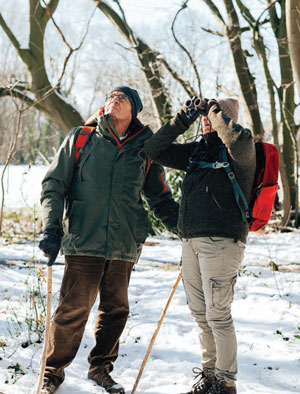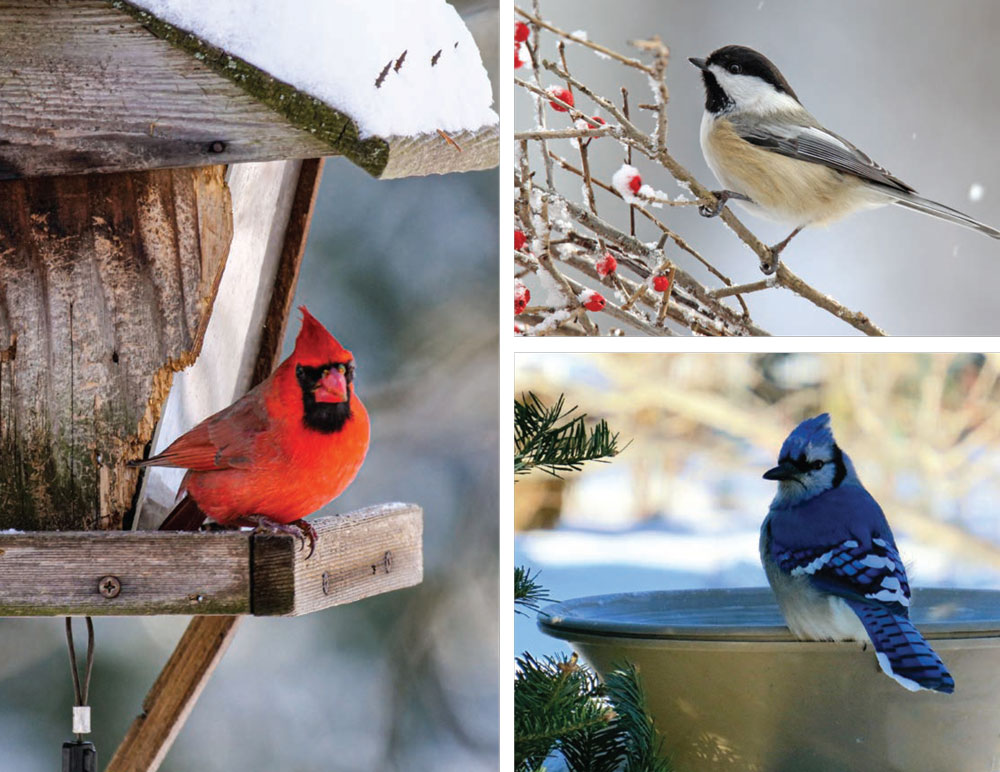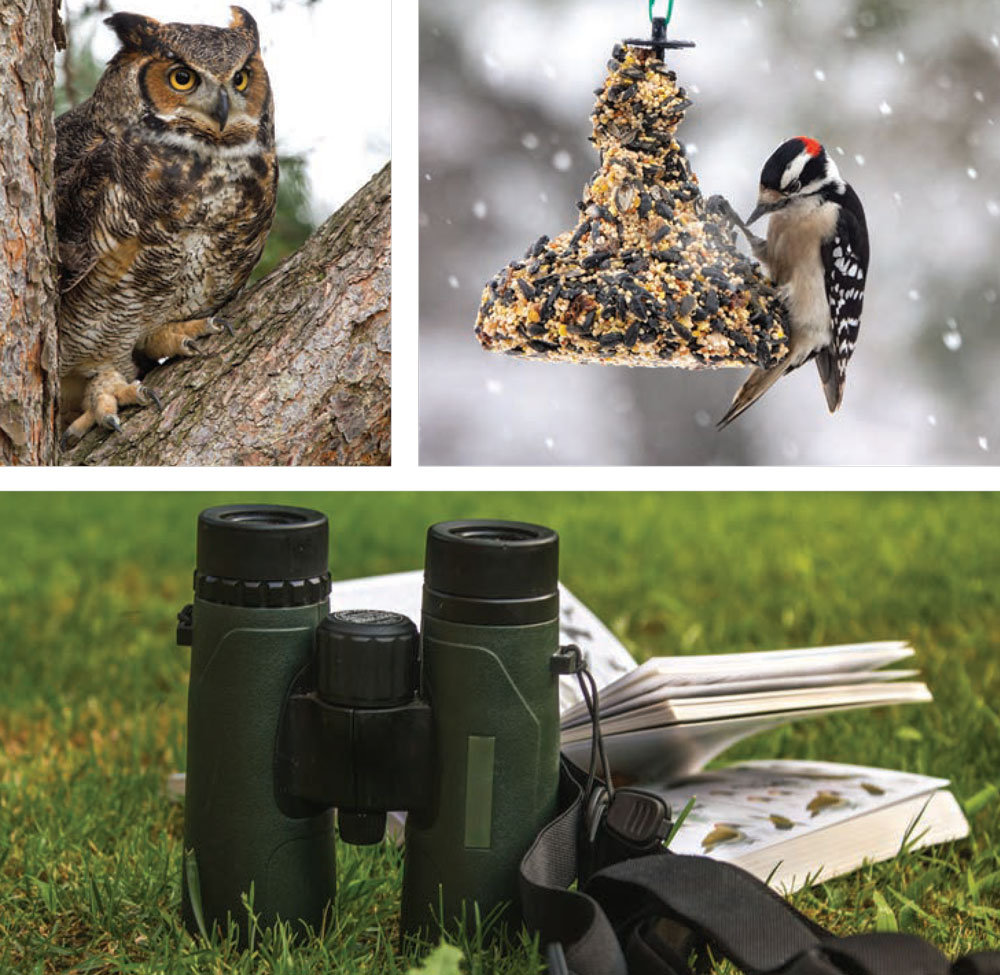A Winter Wonderland of Birding | What Beginners Need to Know

Birdwatching, otherwise known as birding, is an increasingly popular past time. There’s something slightly soothing in the practice that to begin, requires nothing but your attention.
Of course, as one’s interest in birding deepens, you can certainly invest in guidebooks and binoculars, perhaps even a fancy digital camera, but to set out to birdwatch, one only needs to stop and watch the winged creatures already flitting about. And then, once you’ve gotten hooked on the habit, you’ll find yourself looking for birds everywhere you go.
Getting started
All it takes to begin birding is a willingness and a curiosity to observe the outside environment, with a little bit of patience as you become familiar with bird habits. Birding is an activity that can be done almost anywhere, although some areas are better suited for spying a wider variety of birds. Time of day, season and weather can also affect the types and birds you will see. While many birds migrate in the spring and fall, winter is still an excellent time to go birding. The lack of foliage on trees allows more visibility of seasonal visitors you might not see at other times of the year.
You can begin by getting to know the birds in your immediate neighborhood. A spot where birds can find food and water does much to attract them, as does a habitat that provides shelter from the weather. Birds prefer a slightly messy environment – they love a good brush pile or a flower bed left to winter over with unraked leaves and flower heads gone to seed, as that provides them with cover as well as food sources.
Feeding the birds
You can set out food for the birds, preferably in a covered feeder that keeps rain and snow out of the food. High fat foods, like black oil sunflower seed, peanuts, thistle seed and suet are best for feeding birds in winter. Place the feeders close to brush or another protected area like evergreen shrubs or trees – this can help protect the feeder from the worst of winter weather, while also giving the birds a quick escape from any threats.
Having the feeder in a protected spot near the house can also allow you to watch the birds from the comfort of your own home, especially as you begin to get to know your feathered neighbors. It’s important to regularly clean the feeders, as they can spread diseases between birds. You may want to consider deterrents for other pests that may be attracted to either the bird seed or the birds themselves, like squirrels, bears, chipmunks, stray cats and other pests.
Birds won’t require to be fed once the weather warms up and spring blooms, so you won’t need to leave your feeders out all year long. Plant native flowers, shrubs and trees in your garden to make your yard a bird-watching oasis all year long.
Fresh water is another requirement for attracting birds to your winter yard. A heated birdbath isn’t a bad idea, but just a dish kept clear of ice in cold temps works just as well. Like the feeders, it will also need to be cleaned and refreshed regularly. Keeping birdhouses or other nesting boxes up throughout the year also welcomes birds to your yard in cooler weather.
 Beyond the yard
Beyond the yard
Of course, you can also go outside your yard to watch birds. When bird watching in winter, you’ll want to dress for the weather, in colors that blend into the surroundings. Station yourself where two habitats meet, like the edge of a forest or meadow or a shoreline and just begin to observe. It can be helpful to not move around much, as sudden movements can frighten birds into hiding.
The cooler air of mornings carries the songs of birds farther, so there can be a wider variety of birds to be identified during that time of day. You may even discover birds you can hear but can’t see. The same can be true in the evenings, when the darkness hides the presence of birds you can’t see but certainly hear, like owls. While mornings are generally considered a great time for birding, one doesn’t have to be an early riser to be a bird watcher. There is plenty of activity throughout the day to take notice of.
Many birders like to keep notes of the birds they’ve seen and where they’ve seen them. There are both field guides, as well as apps available to help one identify various birds on one’s own while area groups such as the Roanoke Valley Bird Club and the Lynchburg Bird Club host meet-ups of birders. Another excellent resource for local birders is Birding Virginia, which offers local and regional information on birds.
Once you begin paying attention to birds, you’ll probably start noticing other subtle changes in the natural environment around you. Birding is one of those gateway activities that may lead to you spending more time outside, observing your surroundings — a winter wonderland filled with interesting creatures.
BIRDS OF A FEATHER
BIRD CLUBS ARE A WEALTH OF INFORMATION FOR BIRDERS. THEY’LL CONNECT YOU WITH FELLOW BIRD ENTHUSIASTS, CAN HELP YOU IDENTIFY BIRDS, HELP TRACK WHAT’S CURRENTLY PASSING THROUGH THE AREA, POINT OUT THE BEST BIRDING SPOTS, ORGANIZE FIELD TRIPS AND SO MUCH MORE.
Birding Virginia (birdingvirginia.Org) is a statewide organization that offers information about birding throughout the state, including a list of birding hot spots in every area.
The Roanoke Valley Bird Club The Roanoke Valley Bird Club (roanokevalleybirdclub.com) meets the second Monday of the month at 7 p.m. via Zoom. Contact them for the link and more information. ✦
binoculars, birding, Birdwatching, covered feeder, field guides, Fresh water, guidebooks, native flowers, outside environment, peanuts, shrubs, suet, sunflower seed, thistle seed, trees








